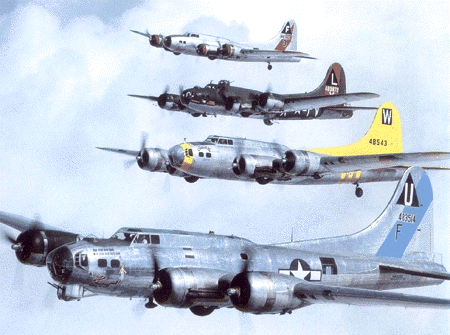 B-17E
B-17EThe B-17E (299-O) was an extensive redesign of that used in previous models up to the B-17D.
The most obvious change was a redesigned vertical stabilizer, originally developed for the Boeing
307 by George S. Schairer. The new fin had a distinctive shape for the time.
Because experience had shown that the plane would be vulnerable to attack from behind, both a
tail gunner's position and powered fully traversable dorsal turret behind the cockpit, each armed
with a pair of Browning M2 .50 cal. machine guns, were added to the B-17E design. Until this
modification, crews had had to devise elaborate maneuvers to deal with a direct attack from behind,
including jerking the aircraft laterally, allowing the waist gunners to alternate shots at enemy fighters.
The configuration with 3-window box would also appear on the B-29, and also adopted by Soviet
bombers as late as the Tupolev Tu-16 Badger, and in different form on the B-52. The teardrop-shaped
sliding panels of the waist gunners were replaced by larger rectangular windows, directly across the
fuselage from each other, for better visibility. In the initial fifth of the production run, the ventral
bathtub gun emplacement of the C and D versions was replaced by a remote-sighted Bendix turret,
very similar to the unit placed on the B-25B Mitchell medium bomber of the same period, which proved
to be a disappointment in usability, resulting in the remaining E-series aircraft being fitted with a Sperry
ball turret, to be used for all succeeding B-17 versions.
A total of 512 were built, making the B-17E the first mass-produced version of the B-17. One of these
was later converted to the XB-38 Flying Fortress. Since production this size was too large for Boeing alone
to handle, it was assisted by the Vega division of Lockheed and Douglas. Boeing also built a new plant, and
Douglas added one specifically for production of the B-17.
In the middle of 1942, 45 B-17Es were transferred to the RAF, where they served under the designation
Fortress IIA. Likely because of the shortcomings of the Fortress I (B-17C), the RAF decided not to use the
Fortress IIA as a daylight high-altitude bomber, the role for which it had been designed. Rather, they were
transferred to the Coastal Command for anti-submarine patrol.
B-17FThe B-17F was an upgrade of the B-17E, although outwardly the types were distinguished only by
exchanging the framed nose-glass that had originated with the B-17B, for a molded one-piece
plexiglas cone. Late production "F" series aircraft received a "cheek"-mounted gun on each side of
the nose, offset in their horizontal placing with the starboard "cheek" emplacement further forward,
and fully feathering paddle-bladed propellers. Numerous internal changes were made to improve the
effectiveness, range, and load capacity of the B-17. However, once placed in combat service, the "F"
series was found to be tail heavy. The weight of gunners and ammunition when combat-loaded moved
the center of gravity rearward from its design point and forced the constant use of elevator trim tab,
stressing this component. In combat the B-17F proved almost immediately to have inadequate defensive
protection when attacked from the front. Various armament configurations of two to four flexible guns
were utilized in the field, as sometimes cannibalized from damaged B-17s' tail gun positions (as one example),
but the problem was not adequately addressed until the introduction of a powered, remotely operated
"chin" turret in the final production blocks of the F-series Fortresses, directly derived from its debut on
the YB-40 experimental "gunship" version.
By using a stronger undercarriage, the maximum bomb capacity was increased from 4,200 lb (1,900 kg)
to 8,000 lb (3,600 kg). Though this modification reduced cruise speed by 70 mph (110 km/h), the increase
in bomb capacity was a decided advantage. A number of other modifications were made, including
re-integrating external bomb racks, but because of its negative impact on both rate-of-climb and high
altitude flight the configuration was rarely used and the racks were removed.
Range and combat radius were extended with the installation in mid-production of additional fuel cells in
the wings. Called "Tokyo tanks", nine self-sealing rubber-composition tanks were mounted inside each
wing on each side of the joint between the inner and outer wing sections. With an extra 1,080 US gal
(4,100 l) to the 1,700 US gal (6,400 l) available on the first B-17Fs, the Tokyo tanks added approximately
900 mi (1,400 km) to the bomber's range.
3,405 were built: 2,300 by Boeing, 605 by Douglas, and 500 by Lockheed (Vega). These included the
famous Memphis Belle. 19 were transferred to the RAF, where they served with RAF Coastal Command
as the Fortress II.

